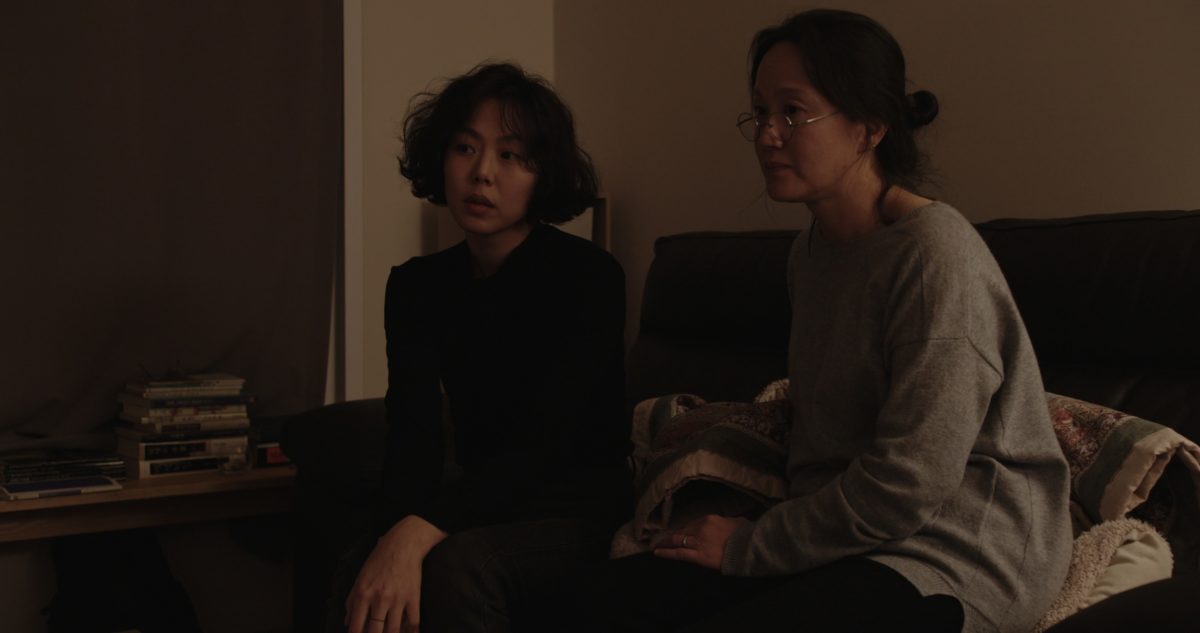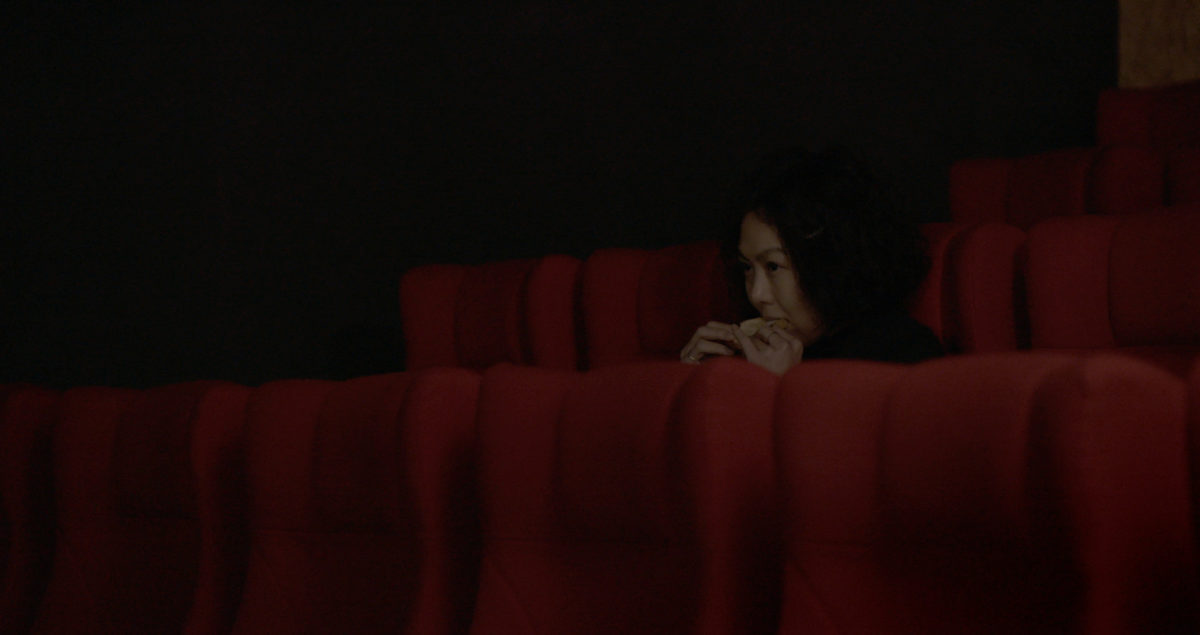In order to paint one must come to see the surface not so much as empty or blank but rather as intense, where ‘intensity’ means filled with the unseen virtuality of other strange possibilities.
Constructions (John Rachjman, 1998)
I have yet to find a review of Rizi (2020) or The Woman Who Ran (2020) that leaves out the words ‘minimalistic style’. Yet, the works of Tsai Ming-liang and Hong Sang-soo must be seen not as an emptying out or abstracting of cinema, but rather as lifelong projects that culminate in the creation of something that is intensely cinematic, specifically in its physical sense of belonging in a theatre, a designated home that houses the body of the viewer. Their most recent projects, both released this year, testify to that particular experience, which phenomenologist Vivian Sobchak finds is being overlooked all too often:
Positing cinematic vision as merely a mode of objective symbolic representation, and reductively abstracting—“disincarnating”— the spectator’s subjective and full-bodied vision to posit it only as a “distance sense,” contemporary film theory has had major difficulties in comprehending how it is possible for human bodies to be, in fact, really “touched” and “moved” by the movies.

Spectacles on!
To speak about the cinema means also to speak about films in the popular circuit. The contemporary popularity of blockbusters makes it so that the most prominent posters on the facades of the houses of cinema are documents of sensory overstimulation. (In comparison to these exuberant splurges of colour and affect, the posters for The Woman Who Ran and Rizi read almost as a haiku: short, composed, evocative.) The abundance of special effects, intensified colour schemes and 3 or 4D promise the ultimate immersive experience: spectacles on! Other than that, the term ‘blockbuster’ does not refer to any stylistic feature nor to any genre. Films that are popular and that make money are simply referred to as ‘blockbusters’, historically speaking the name given to an aerial bomb that has the power to destroy a whole complex of buildings.
In our late-capitalist era, the triumph of this kind of eruptive cinema is not surprising. The ‘blockbuster’ turned out to be true to its name after all. In its typical ways, unfettered capitalism decimated the constitutive core of cinema and spread its debris out globally: long gone is the primacy of the isolated experience in a physical cinema. The rise of streaming on smartphones is but one example of how the power of cinema is diluted for continuous profit, but also of how the need for visual culture is constant.
The contemporary blockbuster is the pinnacle of the spectacle Guy Debord described in his 1967 text:
Considered in its own terms, the spectacle is an affirmation of appearances and an identification of all human social life with appearances. But a critique that grasps the spectacle’s essential character reveals it to be a visible negation of life—a negation that has taken on a visible form.
Evidently, blockbusters such as those set in the so-called Marvel Cinematic Universe are not after any kind of realistic depiction of human social life, yet, while the films lean heavily on action scenes, audiences stay loyal to the series mainly because of its inherent self-referentiality (every film a piece of a puzzle holding a false promise of completion) and because as fans they care for the characters. The audience is invited to invest in what is outside of themselves, effectively escaping from their own immediate concerns. An understandable move, but one that should be examined attentively and carefully if it is to be the dominant mode of immersion to be found in cinemas today. In the popular circuit of the visual arts, a new kind of immersivity has been fully developed, which Oliver Grau distinguishes in Virtual Art: From Illusion to Immersion (2003):
[L]iterary immersions past and present… refer mainly to imagination addressed through words, as expressed by the concept of ekphrasis. They differ fundamentally from the visual strategies of immersion in the virtual reality of the computer and its precursors in art and media history. [My emphasis]
Hong and Tsai are contrarians to this type of engagement and this kind of symptomatic, alienating affect. One of their most important merits is their re-centring of the imagination in the visual arts, without having to rely on literary techniques an sich. In their newest films, they do not lure in the spectator with the magical promise of films as puzzles to be analysed and reassembled meticulously, every mystery eventually uncovered. Their films, contrary to the blockbuster, do not instigate competition (nor hierarchy, which necessarily accompanies it). The puzzle is already solved, it is up to the audience to introspectively deconstruct their own narrative assumptions and expectations.
These filmmakers’ work is a portal into a different world from the one the audience knows, but not one riddled with fantasy—this is not to say the surreal does not make the occasional appearance. If the mode of transportation in a blockbuster is a spaceship, in Hong and Tsai’s films characters travel by foot, taking their time to get there. With wandering as a central notion in the work of Hong and Tsai, each in their own manner change the meaning of immersion.

Televisual aestheticism
Korean director Hong Sang-soo’s filmography almost reads like a sitcom—though he has virtually no experience in making television. It is easy to read some kind of comic continuity into his film titles, as Hong seems to be obsessed with ‘Day’, ‘Night’, ‘the Beach’ and ‘Woman’. In this regard, Woman Is the Future of Man (2004), Woman on the Beach (2006) and Hong’s latest The Woman Who Ran (2020) form an impromptu trio on the comings and goings of women. Considering Hong also wrote and produced most of his films himself, his prolific career is impressive, yet his evolution as a director is all the more interesting as it has followed a downward spiral in terms of his films’ current marketability.
While Hong’s first four features easily top the two-hour playing time, in the last ten years the average length of his films has shrunk to barely reach the 90-minute mark, with the exception of Right Now, Wrong Then (2015) and On the Beach at Night Alone (2017). Hong seems to also care less and less for outward drama. His preference for domestic realism has gone so far as to strip his once high-profile, polished productions from all fantasy and escapades. Even desires have been slowly drifting into the shadows, and even further, off-screen. Hong, who is known for his scenes in which his actors get overly drunk or have uncomfortable sex, leaves not much more in The Woman Who Ran than simple one-on-one conversations. The story is straightforward enough: a woman (Kim Min-hee) visits her friends (Seo Young-hwa and Song Seon-mi) in the suburbs of Seoul, while her husband is away for a few days. Drunkenness is only signalled by Seo Young-hwa’s red cheeks and sex is only mentioned in passing with mild disdain by Song Seon-mi.
In contrast to the modern blockbuster, which is still powered through such overwhelming, grandiose (and senior, since they have been popularized in the Romantic period at the tail end of the 18th century) feelings as the sublime or the tragic, Hong presents no clear affect for the audience to follow. Like theorist Sianne Ngai, Hong is increasingly interested in “states of weakness”, which Ngai in a 2011 interview explains to be
trivial aesthetic categories [such as the cute, zany or interesting] grounded in ambivalent or even explicitly contradictory feelings. More specifically, I’m interested in the surprising power these weak affects and aesthetic categories seem to have, in why they’ve become so paradoxically central to late capitalist culture.
As television turns into streaming service and streaming in turn aspires to be cinematic—the serial blockbuster taking over Netflix and HBO (think: Stranger Things [2016], Dark [2017], Chernobyl [2019])—Hong’s cinema is turning televisual. When he says,
Imagine this rectangle is real life. I try to come as close as possible to it. How? Using details of my life, things I’ve lived, things I heard from other people I know or I just met. I always mix different sources, and it’s never about myself, but it looks like something that happened, or looks like it’s about me. I want it to be like that.
he is in fact describing with accuracy a toned-down version of many of the longest-running television programmes (television series such as Friends, Days of Our Lives, Home and Away—even the very titles are echoed in the names Hong gives to his films) before the rise of the contemporary, hyperdramatized, often dystopic blockbuster.
Another link between Hong’s cinema and TV can be found in the sense of the perverse pervading both reality television and the televisual realism of Hong’s films. Things look real, unscripted, improvised, but how many times have the boundaries of truth been blurred after several seasons of a reality show: was it all pre-conceived by the actors or director? Or only in part? Is there any way to possibly know? If Song’s cheeks or her daughter’s awkwardness or even the street cat patiently and unknowingly waiting outside for some scraps of leftover food—apparently evoking many oohs and ahhs from the audience at its first screening in Berlin—are cute, “our experience of something or somebody as cute is itself easily overpowered by a second feeling of manipulation or exploitation,” Ngai explains.
We were tricked into assuming simplicity, while being truly immersed. We point the finger to actors, we construct and project our own assumptions and expectations onto the film without the film ever giving into them. There is no comprehensive video essay to be made on The Woman Who Ran, because there are no solvable mysteries. We are allowed to guess, but do not know with certainty who it was that ran, or from what. Hong puts up appearances to let an audience in, and behind that veil turns out to be cinema. It is not that the style of The Woman Who Ran is minimal, it is that Hong electrifies his images with a buzzing affect that has plural outcomes. The slow panning over a banal landscape from left to right, the zooming in on a woman’s mouth while eating or the image of a young girl in security camera footage; these moments are so deceptive: undeniably banal, but their confident occurrence brings the audience out of balance.
The audience is steered away from a clear line-of-thought, and put on the edge of their seats. Then come the final few scenes. Kim Min-hee sits in a cinema, watching a—for lack of a better word—minimalist film: images of waves crashing on the shore, calmly, steadily. She relaxes. Perhaps here, Hong is hinting at a motive for filmmaking, though the main body of the film, in which he excites and prods and frustrates the audience’s senses, would suggest the opposite. Rather, I would suggest, he could be hinting at a truce between him and the medium of cinema that assembles before him historically. He shakes the medium’s hand, mourns the loss that he will have to deal with for the entirety of his career, then turns away from it. He has better things to do, life (in the visual arts) must go on.

Undersaturation
All the new thinking is about loss.
In this it resembles all the old thinking.
The idea, for example, that each particular erases
the luminous clarity of a general idea.
‘Meditation at Lagunitas’ (Robert Hass, 1979)
Those who claim alienation to be an overarching trademark in Tsai Ming-liang’s work, must (have appeared to have) led a very eventful life. For claiming that activities such as washing vegetables, (slowly) walking up a hill or being asleep are unrelatable, is a negation of life. Tsai is very aware of his own pursuit; the action in Rizi is banal, but not aimless nor accidental.
Rizi’s narrative (meaning: the soil out of which fertile stories sprout) is easily summarized: two seemingly unrelated men, one of them quite a bit older than the other, turn out to have an unconventional relation. This last bit the audience only finds out after the first half of the film, in which nothing more happens than the younger man cooking at home and the older one looking for a way to relax, visiting an acupuncture studio.
In my own experience, it was myself, rather than the film, that was emptied out; or, to bring that word back once more, minimalized. The anticipation for action is kept at bay for so long, that I slowly descended into a calm state, purging passing thoughts one by one. Yet the screen is full of life; there is no centred energy, but there is steam, incense, water, fire, earthly elements, cats, humans, fish, the elements of life moving in non-linear directions. The intensity of these multi-directional movements—no single explanation attached—is expurgatory for the viewer. It is an experience that submerges more senses than vision alone.
When there are no more thoughts to be examined and be rid of, the viewer having reached a state nearing weakness—something like sleeping with one’s eyes open—Tsai reaches out. He gives in to desire (and it is unnecessary here to claim whose desire). Slowly, but magnanimously, the bodies of two men succumb to each other. One kneads the other’s body in an intimate massage, their mutual magnetism suddenly fixated on the screen. It is a long scene, but a short-lived moment. It is the core moment of Rizi. After its climax, the men feel the post-waves of the pulsating energy, coming together and moving apart softly a few more times. They share a meal and do not see each other again in the film. The tone becomes more subdued again, going back to that state of weakness, which is visually most outspoken in the final shot of Lee Kang-sheng brooding between sleep and wakefulness.
For the viewer this climactic scene is all the more intense, because there is a sudden turn of events—another deception. Now all of the senses are addressed, but although the characters onscreen fulfil their desire for touch, we are only seated in a dark room, confronted with our own aching bodies. Sobchak writes:
in this unthought carnal movement of an ongoing streaming toward and turning back of tactile desire, my sense of touch—“rebounding” from its only partial fulfilment on and by the screen to its only partial fulfilment in and by my own body—is intensified.
In claiming Tsai’s film to be part of ‘slow cinema’, which is often an oblique way to claim a film is boring—which in itself is only a negative claim if a speaker or a critic assigns it that value—it is being positioned as an inversion of the blockbuster. If Rizi is conventionally boring, it is because Tsai wants it to be just that. The film exhibits Ngai’s states of weakness, because it wants to actually engage an audience. It forces the audience to be thrown to the lions residing in themselves. If they refuse to accept the confrontation, they will be eaten alive. All of this is packaged in a silken cocoon, the gestures of softness serving almost as a self-awareness, a shame, an embarrassment on behalf of Tsai for that intense burst of body and skin, love and desire that is at the centre of Rizi.
Rizi is a meditation. It is an invitation for the audience’s minds to wander into anything but a singular, clearly delineated path. The viewer’s experience is intensified, every participant in the audience can effectively construct their own assumptions and expectations. And when all of those are let down or lost, the director brings up a different kind of feeling.
Towards a Lived Cinema
I have explained how Hong and Tsai’s films are inversions of the contemporary blockbuster. I would also argue that the term ‘abstract’ applies only the latter and not the former, for the word itself carries an encapsulating force, a hermetic wholeness, which neither The Woman Who Ran nor Rizi possess nor pursue. Blockbuster films find their way to streaming platforms faster and faster, absorbing a growing percentage of the industry revenue. Many contemporary successful films now have a virtual premiere. With the reopening of cinemas cautiously kept at bay in wake of the recent lockdowns, in 2021, “seventeen movies will each arrive in theatres and on HBO Max simultaneously,” The New York Times reports, calling it “also a strikingly grim comment on the future of movie theaters.”
“What needs to be kept in mind,” as Mark Fisher has said, “is both that capitalism is a hyper-abstract impersonal structure and that it would be nothing without our co-operation.” It is no surprise that for capitalists the future of the medium lies in an abstraction of cinema. Meaning: scattering its being in general. One consequence among others is that cinema is taken more and more out of its original home, into the outside world (which is anywhere and nowhere in specific).
While it is probably possible to be immersed in a film even while watching it on the metro, we are simultaneously asking so much or our senses and are surrounded by so many distractions, that much of the valuable bodily sensations present in the experience of a film are lost. As Sobchak emphasizes in ‘What My Fingers Knew: The Cinesthetic Subject, or Vision in the Flesh’, a piece addressing the difficulty of writing about our actual experience of cinema: “We see and comprehend and feel films with our entire bodily being, informed by the full history and carnal knowledge of our acculturated sensorium.” This also adds to the difficulty of dealing with the term ‘immersion’ in all its ambiguous undertones. I want to bring up Oliver Grau’s text once more:
Immersion can be an intellectually stimulating process; however, in the present as in the past, in most cases immersion is mentally absorbing and a process, a change, a passage from one mental state to another. It is characterized by diminishing critical distance to what is shown and increasing emotional involvement in what is happening.
This kind of immersion (that of the popular blockbuster) is symptomatic of a cinema mediated through profitability. Impeding self-reflection and introspection, there is an ever expanding and bombastic (bomb-like) reservoir of radioactive media content that invades the home. Its residue is impossible to get rid of. In this war of raging visuals, Tsai’s self-distribution in Taiwan, “flogging tickets to passers-by” is a heroic act. Hong already knows the refuge: the dying cinema in his film, the small, deserted room where day after day the same black-and-white reels, long forgotten, are mounted onto the projector. The woman and the medium, finally alone, finally ready to give each other their full attention. And let us not devaluate in any case the conversations after the screening, while walking home or staying in the theatre a bit longer, exercising and stretching the senses.
One of the essential aspects of Hong and Tsai’s films is that they should be viewed in a theatre. Their subtle power arises when the experience of the film can be isolated for the duration of it. Wandering is a key notion in these directors’ work. Instead of centring a focal point within the screen, (forcefully/oppressively) guiding all the audience’s eyes to a single point in the screen, Hong and Tsai’s carelessness about their viewers’ gaze is a tender gesture. They provide us an image, but it is up to us which part of it we would like to fixate.
If anything must be said on the term ‘slow cinema’, it is that it stands as a cinematic home. The magic of it cannot be taken into abstraction, but must be shown on a big screen. An audience must choose to travel towards it. Guy Debord painted the grim picture that “[t]he spectator does not feel at home anywhere, because the spectacle is everywhere.” With Rizi and The Woman Who Ran, Tsai and Hong overcome the spectacle, be it just for a few hours.
For this is what art is: a bundle of affects or, as Deleuze and Guattari would say, a bloc of sensations, waiting to be reactivated by a spectator or participant. Indeed, you cannot read affects, you can only experience them.
The Aesthetics of Affect: thinking art beyond representation (Simon O’Sullivan, 2001)
